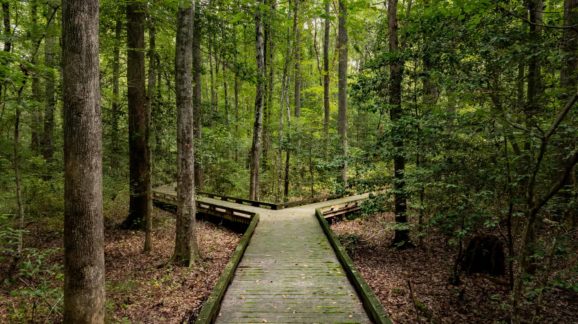Some Good News on Forest Management

Photo Credit: Getty
After a grueling deliberative process, the Senate passed the $1.2 trillion bipartisan infrastructure bill on Tuesday. Speaker Nancy Pelosi (D-CA) has threatened to hold the bipartisan bill hostage in the House until the Democrats’ so-called “human infrastructure” bill arrives via budget reconciliation. Assuming the bipartisan bill eventually passes the House, a total of $5.75 billion will go toward our national forests.
Setting aside the billions of dollars that the bill promises to add to the deficit, there are substantive measures to better manage forests to help prevent and combat catastrophic wildfires out west. While the infrastructure bill intends to accomplish this largely through federal bureaucracy (I argued in an earlier post that the private sector is better equipped to handle forest management), it does use efficient and proven forest management strategies (which I described in my last post).
The bipartisan infrastructure bill correctly identifies neglectful forest management—not climate change—as the primary cause of the western wildfires.
For starters, the bill takes head-on the problem of tree crowding and excess vegetation in many national forests. It appropriates $500 million to the U.S. Forest Service for “conducting mechanical thinning and timber harvesting,” while requiring federal wildland firefighters to spend a minimum of 800 hours a year working on reducing hazardous fuel loads. Reducing the high concentration of trees and other vegetation will cut the potential magnitude of wildfires by extracting much of their fuel. This is especially critical out west, where the bulk of extreme wildfires occur, and where the limited water supply often means that much of the excess vegetation becomes dead and dry, which further feeds the destructiveness of wildfires.
The bill also includes $200 million “for contracting or employing crews of labor to modify and remove flammable vegetation,” so that forest management is not monopolized by the U.S. Forest Service. The discretion of these funds will be decided by the Departments of the Interior and Agriculture, but they should be appropriated towards enlisting the help of private companies, and not through expansive federal programs like the Civilian Climate Corps being pushed by some congressional Democrats in their budget reconciliation bill.
The bill designates another $500 million for “planning and conducting prescribed burns.” While the risk of prescribed burns getting out of hand should be at the forefront of concern for forest management specialists, the technique is extremely beneficial in cutting down excess vegetation while preserving large trees. In fact, the use of controlled burns as a forest management method in the western forestlands predates Europeans’ arrival in the Americas.
The bill also provides financial assistance to “establish, reopen, retrofit, expand, or improve a sawmill or other wood-processing facility” if it is located near federally managed forest that has a high concentration of trees. That will cover much of California, which has an average of 165 to 170 trees per acre, when most forests can only sustain 40 to 60 per acre.
Increasing the number of sawmills and other wood-processing facilities would make it easier for the Forest Service to cut down trees and thin out regions with massive tree concentrations by diminishing the time and hassle of transporting timber over long distances.
Hopefully, opening more sawmills will awaken the Forest Service from its timber harvest slumber. While timber harvesting once was a significant function of the Forest Service—harvesting between 10 to 12 billion board feet in the late 1980s and early 1990s—current harvests have dwindled to around 2.5 billion board feet over the last decade.
If done correctly, the increase in timber harvesting will also make lumber more affordable by increasing the supply. This past spring, the lumber market was hit hard with inflation as a result of both limited production during the pandemic and its recent increase in demand. While lumber production has since caught up this summer, the production of more lumber can help lower its cost further.
The bill also allocates funding for firefighter salaries, collection and modeling of wildfire data for forecasting, multiple studies on wildfire prevention and proper forest management, and traditional infrastructure such as communications technology and roads within national forests.
While the bipartisan infrastructure bill provides crucial resources and strategic goals necessary to ensure healthy forests and combat wildfires ravaging the west, its forest management infrastructure only represents a small fraction of the gargantuan bill’s price tag. Total spending for all forest management and wildfire-related features comes to $5.75 billion, less than half a percent of the entire bill.
It is disappointing that such important matters as providing resources to help fight wildfires, which pose a consistent threat in the west, take such low priority. Still, despite its hefty price tag, the bill is likely to come to fruition. While the massive bill is unlikely to have the broad impact many of its advocates would contend, it is nonetheless commendable that a bipartisan group of senators worked together to develop effective solutions to tackle forest mismanagement and the wildfire crisis.
(This post was updated on August 13, 2021.)